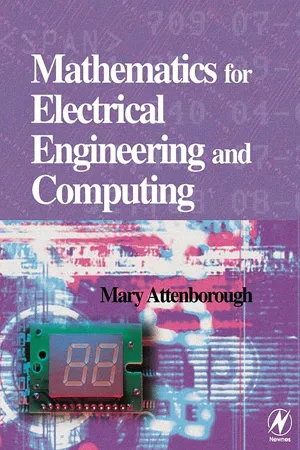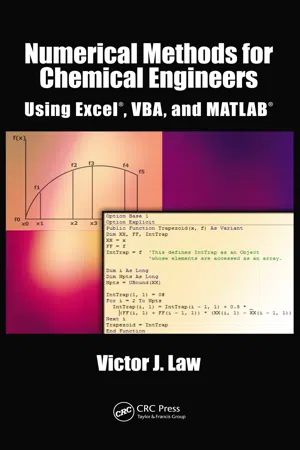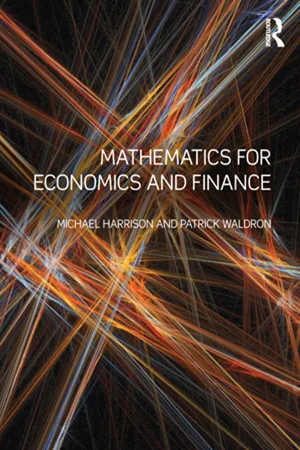Technology & Engineering
System of Linear Equations Matrix
A system of linear equations matrix is a way of representing a set of linear equations using a matrix. Each row of the matrix corresponds to an equation, and each column corresponds to a variable. The coefficients of the variables are arranged in the matrix, allowing for efficient manipulation and solution of the system of equations using matrix operations.
Written by Perlego with AI-assistance
Related key terms
Related key terms
1 of 4
Related key terms
1 of 3
7 Key excerpts on "System of Linear Equations Matrix"
- Mary P Attenborough(Author)
- 2003(Publication Date)
- Newnes(Publisher)
13Systems of linear equations, matrices, and determinants
13.1 Introduction
The widespread use of computers to solve engineering problems means that it is important to be able to represent problems in a form suitable for solution by a computer. Matrices are used to represent: systems of linear equations; transformations used in computer graphics or for robotic control; road, electrical and communication networks, and stresses and strains in materials. A matrix is a rectangular array of numbers of dimension m × n where m is the number of rows and n is the number of columns in the matrix. Matrices are also useful because they enable us to consider an array of numbers as a single object, represent it by a single symbol, and manipulate these symbols conveniently. In this chapter, we look at applications of matrices and arithmetic operations on matrices and some common numerical methods. We shall also look at the problem of solving systems of linear equations. The methods of solving linear systems of equations are well understood and we only need to be able to solve simple cases of such problems ‘by hand’. However, it is important to be able to express a problem in matrix form and also appreciate situations where no solution exists or where more than one solution exists. This allows to analyse the problems of ill-conditioning of systems of equations, which can lead to instability in the solution and the problem of over- or under-determinacy, where either we have too much information, leading to possibly contradictory conditions, or we have not got enough to produce a single set of solutions for the unknowns.We shall also look at the eigenvalue problem. The technique of finding eigenvalues will become particularly important when applied to systems of differential equations which we meet in Chapter 14 .13.2 Matrices
A matrix is a rectangular array of numbers. They may also be used as a simple store of information as in the following example.- eBook - ePub
- R. V. Dukkipati(Author)
- 2023(Publication Date)
- Mercury Learning and Information(Publisher)
2LINEAR SYSTEM OF EQUATIONS2.1 INTRODUCTIONIn this chapter, we present the solution of n linear simultaneous algebraic equations in n unknowns. Linear systems of equations are associated with many problems in engineering and science, as well as with applications of mathematics to the social sciences and quantitative study of business and economic problems. A system of algebraic equations has the form(2.1)where the coefficients a ij and the constants b j are known and x i represents the unknowns. In matrix notation, the equations are written as(2.1a)or simply Ax = b (2.1b)A system of linear equations in n unknowns has a unique solution, provided that the determinant of the coefficient matrix is nonsingular , i.e., if |A | ≠ 0. The rows and columns of a nonsingular matrix are linearly independent in the sense that no row (or column) is a linear combination of the other rows (or columns).If the coefficient matrix is singular , the equations may have infinite number of solutions, or no solutions at all, depending on the constant vector.Linear algebraic equations occur in almost all branches of engineering. Their most important application in engineering is in the analysis of linear systems (any system whose response is proportional to the input is deemed to be linear). Linear systems include structures, elastic solids, heat flow, seepage of fluids, electromagnetic fields and electric circuits, i.e., most topics taught in an engineering curriculum. If the system is discrete, such as a truss or an electric circuit, then its analysis leads directly to linear algebraic equations.Summarizing the modeling of linear systems invariably gives rise to equations of the form Ax = b , where b is the input and x represents the response of the system. The coefficient matrix A , which reflects the characteristics of the system, is independent of the input. In other words, if the input is changed, the equations have to be solved again with a different b - Victor J. Law(Author)
- 2013(Publication Date)
- CRC Press(Publisher)
3 Linear Algebra and Systems of Linear Equations
3.1 INTRODUCTION
Linear algebra is a topic that many students of numerical methods will have been exposed to in mathematics classes. In this chapter, a brief review of linear algebra is given along with numerical methods for solving problems that are common in engineering and scientific applications. Linear algebra involves the manipulation of linear relationships and usually involves the use of vectors and matrices. The most common problem class of linear algebra is the solution of a set of linear algebraic equations.3.2 NOTATION
• Scalars are indicated by a lowercase letter. • Vectors are also identified by a lowercase letter. The context distinguishes between a scalar and a vector. • Matrices are designated by a capital letter.• By default, vectors are column vectors. To show a row vector, the transpose operator (a superscript T ) is used (as in x T ).• When necessary, the dimensions of matrices and vectors are shown by scalar subscripts. For example, A m × n indicates a matrix with m rows and n columns. Further, y n ×1 designates a column vector of n elements.Definition: The equationwhere a , b , c , d , and h are known numbers, while x , y , z , and w are unknown numbers (variables), is called a linear equation . If h = 0, the linear equation is said to be homogenous . A linear system is a set of linear equations, and a homogenous linear system is a set of homogenous linear equations.For example, is a linear system. Butis a nonlinear system (because of ).The system is a homogenous linear system. Vectors and matrices offer a convenient, compact way of representing, manipulating, and solving linear systems. These are introduced in the next few sections.3.3 VECTORS
A vector is an ordered set of numbers arranged as a column (the default). An m- eBook - ePub
- Michael Harrison, Patrick Waldron(Authors)
- 2011(Publication Date)
- Routledge(Publisher)
Systems of linear equations and matrices
DOI: 10.4324/9780203829998-31.1 Introduction
This chapter focuses on matrices. It begins by discussing linear relationships and systems of linear equations, and then introduces the matrix concept as a tool for helping to handle and analyse such systems. Several examples of how matrices might arise in specific economic applications are given to motivate the mathematical detail that follows. These examples will be used again and further developed later in the book. The mathematical material that follows the examples comprises discussions of matrix operations, the rules of matrix algebra, and a taxonomy of special types of matrix encountered in economic and financial applications.1.2 Linear equations and examples
Linear algebra is a body of mathematics that helps us to handle, analyse and solve systems of linear relationships. A great deal of economics and finance makes use of such linear relationships. A linear relationship may be represented by an equation of the formwhere x, y and z are variables and α and ß are constants. Such relationships have several nice properties. One is that they are homogeneous of degree one, or linearly homogeneous, i.e. if all variables on the right-hand side are scaled (multiplied) by a constant, θ, then the left-hand side is scaled in the same way. Specifically, using (1.1 ), we havez = α x + β y1.1z * = α1.2(+ βθ x)(= θθ y)(= θ zα x + β y)Another property of linear relationships is that, for different sets of values for their variables, they are additive and their sum is also linear. Suppose we have the two equations z1 = αx1 + ßy1 and z2 = αx2 + ßy2 , then1.3 after slight rearrangement, which may be written asz 1+z 2= α(+ β)x 1+x 2()y 1+y 2Z = α X + β Y1.4 where X = x1 + x2 , Y = y1 + y2 and Z = z1 + z2 . The result, equation (1.4) , is a linear equation in the sums of the respective variables. The generalization to the case of n equations is straightforward and hasX =., Y∑i = 1nx iand Z =∑i = 1ny i∑i = 1nz iThese simple properties constitute one reason why linear relationships are so widely used in economics and finance, and particularly when relationships, such as demand and supply curves, are first introduced to students.1 - eBook - ePub
- Kenneth M. Shiskowski, Karl Frinkle(Authors)
- 2013(Publication Date)
- Wiley(Publisher)
Chapter 2
Linear Systems of Equations and Matrices
2.1 Linear Systems of Equations
The basic idea behind a general linear system of equations is that of a system of two xy -plane line equations ax + by = c and dx + ey = f , for real constants a through f . Such a system of two-line equations in the xy -plane has a simultaneous solution , the intersection set of the two lines. In general, we consider a simultaneous solution to be the collection of points that simultaneously satisfies all equations in a given system of equations. In the two-line equation system example we have only three possibilities. If the two lines are not parallel, then their intersection set is a single point P; hence the simultaneous solution will simply be {P }. If the two lines are parallel and distinct, then their intersection set is empty and there is no simultaneous solution. Last, if the two lines are the same, the simultaneous solution is simply the entire line, which consists of an infinite number of points. We now give an example of each of these three situations. As you will see, the solution points of each of these three systems are where each pair of lines intersect. In these systems, in order to solve by hand for the solution points, we must try to solve for one of the variables x or y by itself without the other variable. In essence, we are assuming each pair of lines intersect at a single point unless we discover otherwise.Example 2.1.1 . Our first example is to solve the following system:(2.1)In order to solve for one of the variables x or y by itself without the other variable, we can multiply the first equation by 3 and multiply the second equation by 2, which makes the coefficients of y negatives of each other. Now, we can add the two equations together eliminating the variable y , and so solving for x . Similarly, we can solve for y - eBook - ePub
- James R. Kirkwood, Bessie H. Kirkwood(Authors)
- 2020(Publication Date)
- Chapman and Hall/CRC(Publisher)
In order to give the information in a form that is easy to communicate with a computer, it is convenient to use matrices. This also simplifies the notation in solving the system by hand. Instructions to use MATLAB or R to perform the computations of linear algebra, are given in the appendices. Consider the system of equations in the example above. We associate the system of linear equations with the matrix that consists of the coefficients of the variables on the left columns of the matrix and the numbers on the right column for each equation. Thus we have 3 x + 4 y − 2 z = 5 x − 2 y + z = 0 7 x + 4 y − 3 z = 3 ↔ (3 4 − 2 5 1 − 2 1 0 7 4 − 3 3). (1) The matrix on the right in Equation (1) is called the augmented matrix for the system of equations. The vertical line is simply to help separate the coefficients of the variables from the numbers on the right side of the equations, and will not normally appear. There is also the matrix of coefficients associated with a system of linear equations that is occasionally used. In Equation (1) this is (3 4 − 2 1 − 2 1 7 4 − 3). Representing systems of linear equations by matrices is advantageous for computer solutions of the systems. Exercises In Exercises 1–3 find the augmented matrix for the systems of. equations 1. 3 x + 5 y = 9 x − 2 y = − 7 y = 5 2. x − y + 3 z = 6 2 x + 4 y − 3 z = 2 x + y + z = 0 3 y − 2 z = − 8 3. x + y + z = 0 x + y + z = 3 x + 2 y + z = 5 In Exercises 4–6 find the systems of equations associated with the augmented matrix. Denote the variables as x 1, x 2, … 4. (3 − 1 2 0 0 4 1 6 − 2 5 1 − 8) 5. (8 3 0 6 − 4 2 1 2) 6. (1 0 4 2 6 3 2 1 − 7 − 3 0 0 2 0 2 − 2 4 − 1 5 0) Section 2.3 Equivalent Systems of Linear Equations The manipulations of a system of equations that yield an equivalent system of equations have corresponding manipulations with the associated matrix. These manipulations correspond to multiplying the augmented matrix by particular elementary matrices - eBook - ePub
Linear Algebra
An Inquiry-Based Approach
- Jeff Suzuki(Author)
- 2021(Publication Date)
- CRC Press(Publisher)
all equations are in standard form, we’ll be able to work with the vectors as easily as we could have worked with the equations.For example, the system of equations3 x + 5 y= 112 x − 7 y= 4could be represented as the vectors〈 3 , 5 , 11 〉and〈 2 , − 7 , 4 〉, where the first component is the coefficient of x; the second component is the coefficient of y; and the last component is the constant.Actually, if we write our two equations as two vectors, we might forget that they are in fact related. To reinforce their relationship, we’ll represent them as a single object by throwing them inside a set of parentheses. We might represent the evolution of our notation asAs a general rule, mathematicians are terrible at coming up with new words, so we appropriate existing words that convey the essential meaning of what we want to express.{→3 x + 5 y= 112 x − 7 y= 4→〈 3 , 5 , 11 〉〈 2 , − 7 , 4 〉()3 5 112− 74In geology, when precious objects like gemstones or fossils are embedded in a rock, the rock is called a matrix. The term is also used in biology for the structure that holds other precious objects—the internal organs—in place, and in construction for the mortar that holds bricks in place. Thus in 1850, the mathematician James Joseph Sylvester (1814–1897) appropriated the term for the structure that keeps the coefficients and constants of a linear equation in place.Since the matrix shown includes both the coefficients of our equation and the constants, we can describe it as the coefficient matrix augmented by a column of constants or, more simply, the augmented coefficient matrix
Index pages curate the most relevant extracts from our library of academic textbooks. They’ve been created using an in-house natural language model (NLM), each adding context and meaning to key research topics.
Explore more topic indexes
Explore more topic indexes
1 of 6
Explore more topic indexes
1 of 4






